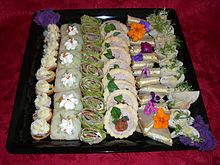Canapé
Canapés or sofas (in the 18th century by French canapé borrowed "sofa" in the original meaning, see sofa ; in the transmitted as "lush took bread slice" probably in 1900 from the English ) are in the upscale German cuisine palatable cut entrees or appetizers that come from classic French cuisine and that are small enough to be easy to eat in a bite or two. Canapés are therefore served without cutlery ( finger food ) and are among the dishes that are traditionally served at receptions and cocktail parties .
Cocktail bites and sandwiches are not canapés.
Manufacturing
Canapés are arranged according to type on mirror, glass or silver plates:
- from small square or round cut slices of bread or from mini baguette (also debarked toast bread , pumpernickel or crackers)
- Spread thinly with butter or seasoned butter (lemon and salt - possibly other variations)
- Thinly topped with fish, crustaceans, shellfish, roasted meat (e.g. roast beef ) or boiled meat (e.g. vitello tonnato ), cheese, sausage products, bacon, ham, various spreads (Liptauer, herb spreads). The covering is cut exactly to the size of the base.
- Garnished with a maximum of 3–4 garnishes (herbs, vegetables, fruit, quail eggs, caviar and much more)
- Freshly plucked leaf salads can be placed on top of the spread
- In special cases, the canapés are also thinly coated with aspic .
Surname
From the Oxford "Dictionary of the Diner":
“The word canapé literally means 'sofa' in French and ultimately comes from the medieval Latin canopeum , which is also the source for the English canopy / d. i. 'Baldachin' / is, and the idea behind its gastronomic use is that the toppings - anchovies, caviar, smoked salmon, ham, etc. - sit on the slices of bread like on a sofa. It is a relatively recent loan into English and is first found in Mrs. Beeton's cookbook from 1890. "
International
Germany
In Germany they are also known as sandwiches or sandwiches known. It is mostly a question of topped slices of bread cut into small pieces. Traditionally, they are garnished with sliced pickles , pickled onions and parsley . Also radishes are often served it. Opened rolls , on the other hand, refer to filled rolls / round pieces / rolls.
Austria
In Austria, canapés are offered as sandwiches or cocktail rolls.
United States
The most popular country for canapés was the United States, where they became popular along with cocktail parties in the 1920s and 1930s, and where dozens of books of canapé recipes appeared on the market. The first to deal exclusively with canapés was Rachel Bell Maiden's The Canapé Book (New York 1934).
Other countries
- Denmark: Smørrebrød , often imaginatively sandwiched sandwiches
- in the UK also open sandwich
- Switzerland: Mainly Canapé also Brötli , beleiti Brötli or sandwiches
- Sweden: sofa
- Czech Republic: Chlebíčky
literature
- Rachida Amhaouche: Canapés and other hearty nibbles. Translated from the French by Daniela Caesar. Ed. Chaaraoui, Casablanca 2009, ISBN 978-9954-1-3099-5 .
- Constance Borde, Sheila Malovany-Chevallier: Sandwiches & Canapés. Kubik RvR, Kehl 2005, ISBN 3-938265-15-9 .
- Christine Smith: Canapés: small delicacies for connoisseurs. Translated from the English by Oliver Stroh. Bauer, Bad Wiessee 2004, ISBN 3-936440-53-0 .
- James Beard: Hors D'oeuvre and Canapés, with a Key to the Cocktail Party. M. Barrows and Company, New York 1940. New edition: James Beard's Hors D'oeuvre & Canapés. James Beard Library of Great American Cooking. Running Press, Philadelphia 1999, ISBN 0-7624-0664-X .
Web links
Individual evidence
- ↑ Food Timeline , accessed August 16, 2014
- ↑ a b they can be easily eaten in one or two bites by guests who are standing and holding drinks. In: Andrew F. Smith (Ed.): The Oxford Companion to American Food and Drink. Oxford University Press, Oxford 2007, p. 89.
- ↑ a b c d Herrmann, F. Jürgen: Textbook for cooks . Handwerk und Technik, Hamburg 1999, ISBN 3-582-40055-7 , p. 280-281 .
- ↑ John Ayto: The Diner's Dictionary. Word Origins of Food and Drink. Oxford University Press, Oxford 2012, p. 59.
- ^ Mrs. Beeton's Everyday Cookery Book and Housekeeping Book. posthumously expanded edition. Ward Lock & Co, London 1890. (Reprint as: Mrs. Beeton's Cookery Book and Household Guide. Cosimo Classics, New York 2007, ISBN 978-1-60206-879-7 )
- ^ The Oxford Encyclopedia of Food and Drink in America. Volume 1. Oxford University Press, Oxford 2013, p. 289.
- ↑ buns . In: Ulrich Ammon, Rhea Kyvelos (ed.): German dictionary of variants: the standard language in Austria, Switzerland and Germany as well as in Liechtenstein, Luxembourg, East Belgium and South Tyrol. Walter de Gruyter, 2004, ISBN 3-11-016574-0 , p. 139.

